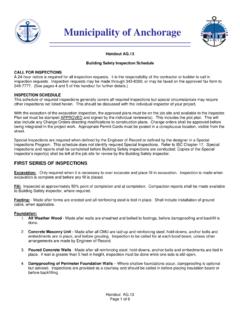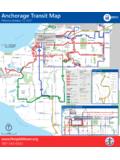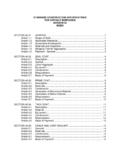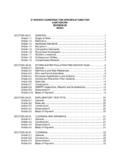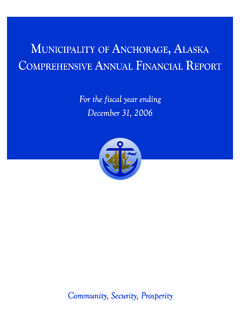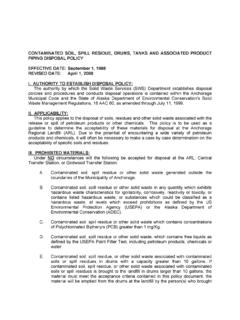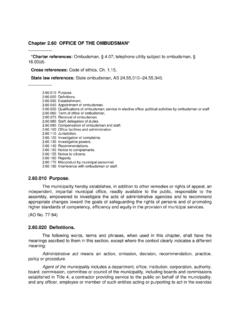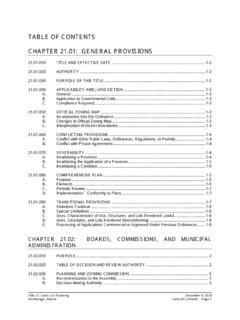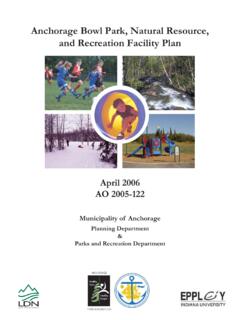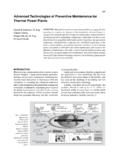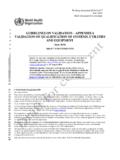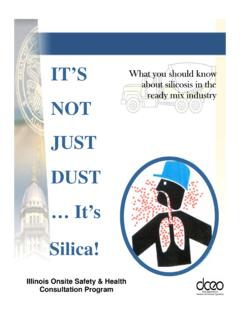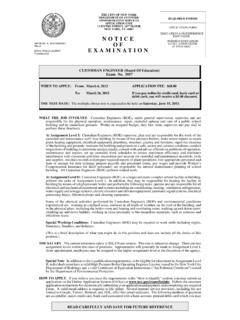Transcription of A Food Worker’s Guide to the Anchorage Food Code
1 A food Worker s Guide to the Anchorage food code 1 Role of the Person in Charge and Demonstration of 2 Employee 7 Hand Hygiene and Bare Hand 10 Storing, Preparing, and Serving 12 Protecting food from 12 Potentially Hazardous 14 Holding 14 14 14 15 15 Using Time to Limit Bacterial Growth (Time as a Control).. 17 Discard Dates for Potentially Hazardous Foods (Date Marking).. 18 Serving Raw or Undercooked Animal 20 Consumer Notification: Disclosure and 20 Parasite Destruction for Raw 21 Serving Molluscan Shellfish (Oysters, Clams, Mussels, Scallops).. 22 Chemical Use and 23 Water and 25 Hazard Analysis and Critical Control Points (HACCP) and 26 Inspections and 27 Form 1: Risk 30 Form 2: food Establishment Inspection 32 Form 3: Employee Health 33 Form 4: Employee Health Decision 34 Form 5: Foods Exempt from Date 45 Sample Test 48 1 In 2010, a new Anchorage food code based on the 2005 FDA Model food code was adopted by the Municipality of Anchorage .
2 This food code is focused on the prevention of foodborne illness and the protection of consumer health. This booklet is designed as a reference for anyone responsible for preparing, serving, or storing food for public consumption in the Municipality of Anchorage . food facilities located outside of the Municipality of Anchorage are regulated by the Department of Environmental Conservation. The regulations in facilities inspected by the Department of Environmental Conservation may be different than those described in this booklet. All permitted food establishments in the Municipality of Anchorage must adhere to the Anchorage food code (AMC ) and the adopted sections of the 2005 FDA food code . This booklet is intended to be used as a Guide for food workers in both regular facilities and temporary facilities. Section AMC of the Anchorage food code specifically addresses additional regulations that apply to temporary and seasonal temporary facilities.
3 In this booklet, items that pertain specifically to temporary and seasonal temporary facilities are underlined. Thank you for reading this booklet and all that you do to serve safe food . We offer a 30 question multiple choice test based on the information in this booklet. Those who pass this test have earned an Anchorage food Worker Card that is valid for 3 years. This card does not substitute for the Certified food Protection Manager exam. Definitions Bacteria: Microscopic, single-celled living organisms. Listeria, E. coli, Shigella, Campylobacter are all bacteria. Bare Hand Contact: Touching or handling an item with bare hands. Certified food Protection Manager: Individual who has successfully completed a food safety examination for food managers from an accredited program. Commissary: A permitted food establishment where operators can store and prepare food .
4 Date Marking: Labeling a food with the day or date the food is prepared or the date or day the food must be discarded. Demonstration of Knowledge: Ability to show through words or actions that an individual understands how to store, prepare, and serve food safely. Foodborne Illness: Disease or illness that resulted from eating one or more foods. HACCP: Acronym for Hazard Analysis and Critical Control Point. It is a detailed food preparation plan to ensure food safety. 2 Highly Susceptible Population: Those who are more likely than the general population to experience a foodborne illness. Pre-school children, the elderly and those with weak immune systems are highly susceptible to foodborne illness. Jaundice: Yellow discoloration of the skin and eyes. Parasite: An organism that lives in or on an organism of another species.
5 Person in Charge (PIC): An individual who is present at a food establishment and responsible for the operation. Potentially Hazardous food : A food that requires time or temperature control to limit bacterial growth. These foods are also referred to as Time/Temperature Control for Safety Foods. Ready to Eat food : food that can be consumed without further washing, cooking, or processing. Risk Type: The level of risk in a food facility based on procedures used in the food operation as determined by a risk assessment. The risk assessment form is found in AMC and on page 30 of this booklet. Seasonal Temporary Facility: A permitted food establishment that is at one location, operates no more than 2 days each week, and operates for less than a 120 day period. Temporary Facility: A permitted food establishment that is at one location for no more than 21 consecutive days.
6 Variance: A written document issued by the Department of Health and Human Services that allows a modification or waiver of one of the requirements in the Anchorage food code . Virus: An infectious, non-living material that infects a living cell. Examples of viruses include Hepatitis A and norovirus. Role of the Person in Charge (PIC) and Demonstration of Knowledge Serving safe food doesn t happen by accident. food is stored, prepared, and served safely when management and workers deliberately incorporate specific actions or procedures to control foodborne illness risk factors. An example of a specific action that controls a foodborne illness risk factor is to always wash hands properly before beginning food prep work. There are five categories of foodborne illness risk factors. They are: 1. food from unsafe sources; 2. Inadequate cooking; 3.
7 Improper holding temperatures; 4. Contaminated equipment; and 3 5. Poor personal hygiene. To effectively reduce foodborne illness risk factors, managers in retail and food service establishments must focus their efforts on controlling and reducing these risk factors in order to prevent foodborne illness. This deliberate approach to preventing foodborne illness is known as active managerial control. A Person in Charge (PIC) must be present anytime food is being prepared or served. The PIC is responsible for the operation and has many responsibilities including supervising and training staff and preventing ill employees from working in a food facility. Usually, the PIC will be an owner or manager. If someone who is usually the PIC, such as a manager, is not in the facility, then someone else must be designated as the PIC. The PIC must have the knowledge and the authority to ensure that safe food handling practices are followed at all times.
8 The PIC must demonstrate that they have a basic level of food safety knowledge. There are three ways for a PIC to demonstrate knowledge of food safety practices: 1. Complying with the food code by having no critical violations during the inspection; 2. Having a current food protection manager certificate; or 3. Correctly answering an inspector's questions about food safety as they relate to the specific food operation. Critical violations are more likely than other violations to contribute to food contamination, foodborne illness, or an environmental health hazard. On the inspection form on page 32 of this booklet, the items under the category Foodborne Illness Risk Factors and Public Health Interventions are the critical violations. They include good hygienic practices and proper cooking temperatures for potentially hazardous foods. If a facility does not have any critical violations noted on their inspection, then the demonstration of knowledge requirement has been met.
9 The second way for a PIC to demonstrate knowledge of food safety practices is to have a food protection manager certificate. food protection manager certificates must be from an accredited program and are valid for 5 years. To meet the demonstration of knowledge requirement with a food protection manager certificate, the individual who has the certificate must be present during the inspection and be the PIC. If the individual who has the food manager certificate is not present during the inspection or is not the PIC, then the person who is the PIC must demonstrate knowledge through one of the other two options. If a facility has critical violations during the inspection and the PIC does not have a food manager certificate, then the PIC needs to demonstrate knowledge through the third option. This is accomplished by correctly answering the inspector s questions about food safety as it pertains to their specific establishment.
10 For example, if during the inspection lunch meat is sitting on the counter and measured at 55 F, then the PIC needs to demonstrate that they know the lunch meat needs to be held at 41 F or below. 4 The potential topics and questions that may be asked to satisfy the third option for demonstrating knowledge come directly from the 2005 FDA food code . All of these topics are addressed in further detail in this booklet and are listed here for reference. The topics that a PIC needs to understand to satisfy the third option of demonstration of knowledge requirement are: 1. Describe the relationship between the prevention of foodborne disease and the personal hygiene of a food employee; 2. Explain the responsibility of the PIC for preventing the transmission of foodborne disease by a food employee who has a disease or medical condition that may cause foodborne disease; 3.
